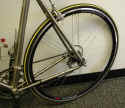Summary:
--Nice finish
--Nice ride
--Reasonably light and fast
--Super value for the money
--Ditch the lousy quick release levers |
October 17, 2002- We Test the Scirocco Wheelset
It has been several years since Campagnolo began offering complete wheelsets, making it possible to have a completely Campy-Only bicycle. From complete disks to high-profile time trial wheels (such as Vento and Shamal) to climbing wheels, a wide variety o styles and trim level have been available.
Your C-O webmaster has been using various Campagnolo wheels since 1997, when we started riding the first generation Proton wheels. Our experience with the Proton wheels was not altogether good, but we have had great experiences with wheels since then.
Campagnolo's current crop of wheels spans the range from the ultra-expensive (such as Hyperon, an all-carbon climbing wheelset) to the merely expensive and moderately expensive. For our latest road test, however, we chose to go down the lineup to one of Campagnolo's least expensive
wheelsets--Scirocco.
 |
 |
 |
 |
 |
 |
|
Note: Photos show Daytona/Centaur quick
release levers |
|
Scirocco
Scirocco (the name means "hot wind from the desert"--remember the Volkswagen Scirocco of a few years ago) is a medium-profile wheel that lies somewhere between more "pure" climbing wheels such as Neutron and Electron and higher-profile time trial wheels such as Bora and Shamal.
The rims are 30mm tall, a depth that requires either long-stem valves or valve extenders. Spoking on both the front and rear wheels features the "G3" pattern, in which two spokes from one hub flange are paired with one spoke from the opposite side. The front spokes are basically radially laced (due to the G3 pattern, some of the spokes are not truly "radial"). At the rear, the non-drive spokes are radial; on the drive side, the spokes are laced 2-cross (much like the Eurus, Proton, and Electron wheelsets). (Note: Scirocco wheels are
closely related to Campagnolo's Zonda model, which has slightly better
hubs and a slightly different spoking pattern.)
The hubs are basically a set of Veloce hubs with a blacked-out treatment. The front hub is exactly like the hubs on the
Campy Only Bianchi; the rear hub features the hourglass-shaped HPW design but uses Veloce-style internal parts, axle, and bearings. (Note:
Campagnolo will not warranty individual hubs which are built with radial
spoking, presumably because the hubs can't stand the higher stresses
involved. Why Veloce hubs can't be laced radially but Scirocco
hubs can is a question we can't answer.)
We mentioned that the Scirocco wheelset is among the least expensive offered, and indeed its price is one of its most
appealing features. You can expect to pay around $300 for a complete Scirocco wheelset at your LBS (somewhat less online
or via mail order), a price that includes skewers, a Michelin rim strip, and a locknut for the freehub.
You probably won't get Campagnolo's wheel bags, but at this price, who
needs them?
At about $300, the Scirocco wheelset--completely built--is most likely less expensive than buying a Veloce hubset, a pair of rims, and spokes, and paying for a wheelbuilder's services.
These wheels are an amazing bargain.
How do they keep the price so low? Well, the hubs are obviously a starting point--the blacked-out finish looks cool, and it also saves the trouble of polishing the hub shells. Veloce/Scirocco hubs are somewhat dated, lacking the new adjustment system available on Centaur, Chorus, and Record hubs, and they are little on the heavy side; we have been using Veloce hubs for more than a year, and neither feature has turned out to be an issue for us.
(If you're shooting for a 17-pound bike, don't use these wheels; if
you're not, they will work just fine.)
The spokes are another; for this wheelset, Campagnolo has used standard spoke nipples (brass), their more expensive wheels use a more sophisticated internal nut system that also eliminates the aerodynamic drag of the spoke nipples.
The Road Test
As of this writing, we've put about 600 miles on our Sciroccos, including a double century that included miles of rough California back roads. Here are our impressions:
Out of the Box
We were impressed with these wheels when we received them. Both wheels were straight and true, and the overall finish was very good.
The supplied Michelin rim strip is strong and light and installs
easily. The only feature we didn't like was the quick release
levers (see "A Minor Glitch," below).
The Ride
We went from a set of "standard" wheels built with Mavic Open Pro rims (2x spoking front, 2x/3x rear), and the change to the Sciroccos was
immediately apparent. Although these wheels are somewhat heavy, most of that weight is additional mass is contained in the hubs, where it matters least. As a result, the wheels accelerate and climb well. They are not as lively as our Electrons, and riders used to Eurus or other lighter wheels might notice a difference, but for the money, these wheels are fast.
Those rough roads didn't pose a problem, either. Most likely because of the long spans of rim between the spoke groups, the wheels soak up road shock quite well, making them quite appropriate for all-day riding.
After some 600 miles of riding, we have yet to need to true the rims--the wheels have stayed remarkably true.
A Minor Glitch
The only complaint we have about these wheels are the quick release levers. Simply put, it's hard to figure why Campagnolo put such a cheap, heavy set of quick releases on these wheels. The levers are steel, unattractive, and seem to be taken from a product line far below Veloce (our Veloce gruppo came with nicer QR levers). The adjusting nut is solid steel, and could be used quite effectively as a paperweight. We took one look at these levers and put them on our commute bike, where weight and appearance don't matter quite as much.
Other Road Tests and
Reviews:
|
